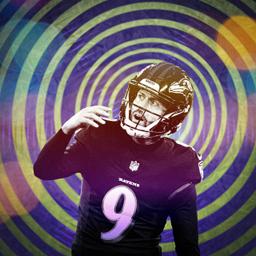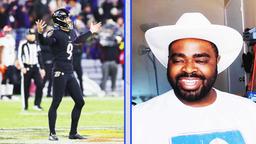Playing quarterback for the Dallas Cowboys certainly has its perks. The most obvious? Just look at Dak Prescott’s catalog of endorsement deals. Prescott’s not the most interesting character at the quarterback position, but he spends a lot of time on national television, which has earned him enough clout to land deals hawking yogurt and mattresses to the American public. There’s a downside to all that attention, though: Sometimes the roster around you gets overrated based on name recognition alone.
The prevailing notion throughout Prescott’s nine seasons in Dallas has been that the team surrounds him with talent. The offensive line has been seen as one of the best in the league since his rookie season in 2016. And playing with Dez Bryant, CeeDee Lamb, Amari Cooper, Brandin Cooks, and Michael Gallup has also created the perception that Prescott’s been blessed with a deep receiving corps. But look at the supporting cast around Prescott the past few years, and it becomes clear that the perception of the Cowboys offense doesn’t match the reality.
The Cowboys offensive line hasn’t ranked higher than 20th in pass-block win rate in the past four seasons, per ESPN. Its success rate in the run game has been closer to mediocre than good over that span, finishing from 11th to 21st in each of the past four seasons, per TruMedia. And here’s a year-by-year look at the team’s leaders in pass targets since 2021:
Dallas's Leaders in Pass Targets Since 2021
Dallas has had plenty of big-name receivers come through the locker room over the past decade, but it hasn’t had two together in their respective primes. Prescott’s found success anyway: From 2020 to 2023, only three quarterbacks were better than Prescott by expected points added—Patrick Mahomes, Josh Allen, and Aaron Rodgers (who won two MVP awards over that span). But now, thanks to Wednesday’s trade with the Steelers for the mercurial but talented George Pickens—for whom the Cowboys functionally gave up just a third-round pick!—the dream of what the Dallas passing game could be may finally be realized.
With Pickens joining Lamb, Dallas will have one of the league’s best receiving duos (assuming the two don’t get in a sideline fistfight over targets). And it’s crafting a unit that’s prepared to play a modern, pass-first brand of offense. This isn’t the run-game-led Cowboys team that we saw early in Prescott’s career. That approach eased his transition to the NFL, but it made his job more difficult once the offensive line and running back room started to age. This version of the Dallas offense, though, is built to pass the ball early and often. And it’s also built to combat the defensive game plans that have always seemed to beat the Cowboys in big games. Many of Dallas’s most significant defeats—a number of which have come at the hands of the 49ers—have followed the same general script: The Cowboys fall behind early and become one-dimensional on offense. The opposing defense is able to get into pass rush mode and generate tight man-to-man coverage on Lamb. Prescott is forced to rush throws and test tight windows with secondary receiving options, and that leads to turnovers and an ugly final score.
That’s how the entire 2024 season seemed to play out in Dallas. The Cowboys couldn’t run the ball efficiently, and they didn’t have a reliable vertical receiving threat to spread defenses out. So opponents could press the line of scrimmage and disrupt the timing of Mike McCarthy’s West Coast passing game. The entire pass game broke down in the face of all that pressure, and Prescott went down with a season-ending injury in Week 9. Lamb put up decent counting stats on the season, but his efficiency numbers fell off a cliff compared to 2023.
Pickens can help solve a number of those problems. First, the former Steelers receiver is a certified vertical threat and doesn’t need to create separation to make plays downfield. Pickens finished second in the NFL in receiving yards on deep targets last season (515), and on those targets he had a “catch rate over expected” of plus–16.7 percent, per NFL Pro. He also ranked second in receiving yards on contested targets, with 301, per Pro Football Focus, and nobody in the top five came close to matching his 25.1 yards per reception average on those plays.
Pickens caught just 12 of his 31 contested targets last year, but only 19 were deemed catchable by PFF’s charting. With better quarterback play, Pickens could be even more productive on 50/50 opportunities. And his reputation alone—as a receiver who dominates at the catch point on downfield targets—should deter press coverage and help solve the main problem that plagued the Cowboys passing game in 2024.
Pickens also fits in well alongside Lamb. Lamb poses his biggest threat from the slot, where he can work the middle of the field. There is naturally a lot of traffic in that part of the field, but in previous seasons, opposing defenses could surround Lamb without fear of Jalen Tolbert or KaVontae Turpin making them pay for it. Dallas tried to move Lamb out wide more often last season to get him some space, but that just spread him thin and hurt his overall production. Last year was the first in which Lamb lined up out wide more often than in the slot since 2021, and he averaged a career-low 11.8 yards per reception. His average depth of target also dropped to a career-low 7.8 yards.
The best illustration of the pass game issue was the 47-9 loss to the Lions in Week 6, when Detroit doubled Lamb in obvious passing situations and dared Prescott to use his other receivers to beat tight man coverage. This is just one of the 15 plays in which Lamb faced a double-team in the game, but there was a lot of this going on in Dallas throughout the 2024 season.
The Lions bracketed Lamb’s vertical route with a cornerback and a safety, leaving Tolbert in one-on-one coverage on the backside. Prescott was forced to rush a deep throw off his back foot after his right guard was beaten immediately, and though he gave Tolbert a chance at the catch point, the diminutive receiver couldn’t make a play on the 50/50 ball.
Dallas had one of the league’s worst passing games when defenses aligned in a press look before the snap. Only the Browns and Giants averaged a lower EPA per play (minus-0.15) on those snaps, and only three teams faced more press looks in 2024, per Pro Football Focus. Meanwhile, in Pittsburgh, the Steelers saw the seventh-fewest press looks in the league and averaged 0.01 EPA per play on those snaps. That ranked only 20th in the league, but that was a good result for what was otherwise a bad Steelers passing game.
We’ll have to wait to see how Pickens gets along with the rest of the Cowboys locker room and whether there’s any bickering between him and Lamb over target shares. But on paper, this move should bring the best out of both receivers. Pickens will get more one-on-one looks on the perimeter and will be paired with a better quarterback, and Lamb should enjoy more space over the middle. But make no mistake, Prescott is the biggest winner in this deal—and one of the biggest winners of the offseason. The Cowboys have patched up a young offensive line that should naturally improve in 2025, and with a younger, more electric backfield consisting of free-agent signing Javonte Williams and fifth-round rookie Jaydon Blue, they’ll no longer be spoon-feeding carries to a washed-up Ezekiel Elliott. Even if the run game isn’t that much better, Prescott now has two load-bearing receivers he can lean on when opponents force the Cowboys to be one-dimensional.
If Pickens is a seamless fit in Dallas’s locker room, or even if he just doesn’t cause too much trouble, this could be the most talented receiving corps the Cowboys have ever put around their $60-million-per-year quarterback. If this setup fails, though, and Dallas has another postseason disappointment, pointing the finger at Prescott may finally be justified.


